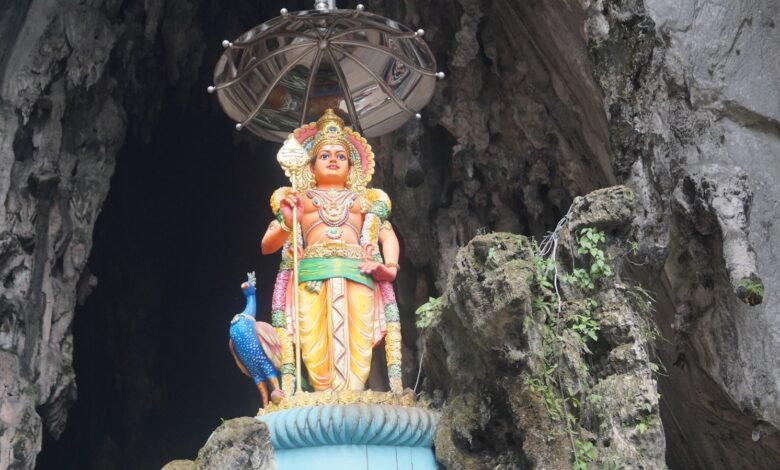
Located just 13 kilometers north of Kuala Lumpur, Batu Caves is one of Malaysia’s most famous and important religious sites. This impressive limestone hill, with its series of caves and temples, is a place of spiritual significance for Hindus and a popular tourist destination. Known for its towering golden statue of Lord Murugan, the steep staircase leading to the main temple cave, and the natural beauty of its caves, Batu Caves offers a unique combination of religion, culture, and nature.
The Religious Significance of Batu Caves
Batu Caves is a major pilgrimage site for Hindus in Malaysia and across the world, especially during the annual Thaipusam festival. The caves are dedicated to Lord Murugan, the Hindu god of war, and the site holds deep spiritual importance in Hinduism. The caves were first used as a place of worship in the late 19th century when the first temple was built inside the caves by an Indian trader.
The highlight of Batu Caves is the 272-step staircase that leads up to the Temple Cave, where the main shrine dedicated to Lord Murugan is located. This climb is both a physical and spiritual journey, symbolizing the ascent to enlightenment. For many devotees, especially during Thaipusam, the climb is an act of devotion, with some carrying kavadi—decorated frames symbolizing burdens—on their shoulders as offerings to the deity.
The Iconic Lord Murugan Statue
One of the most striking features of Batu Caves is the enormous statue of Lord Murugan that stands at the foot of the caves. At 42.7 meters (140 feet) tall, this statue is the tallest statue of Lord Murugan in the world and a prominent symbol of the site. The gleaming golden statue, which took three years to build and was unveiled in 2006, is a breathtaking sight and a favorite spot for photos.
The statue stands guard over the entrance to the caves and welcomes visitors as they embark on their pilgrimage or exploration of the site. Its towering presence reflects the significance of Batu Caves as a place of worship and pilgrimage.
The Cave Complex: Exploring the Wonders of Batu Caves
Batu Caves is not just a single cave, but a complex of several caves, each with its own unique characteristics and significance.
1. Temple Cave (Cathedral Cave)
The Temple Cave, also known as Cathedral Cave, is the largest and most visited of the caves. After climbing the 272 steps, visitors reach the vast interior of this cave, which has a high ceiling and is open to the sky at several points. The cave houses several Hindu shrines, statues, and altars, with the main shrine dedicated to Lord Murugan located at the far end of the cave.
The Temple Cave’s immense size and natural beauty, combined with the religious artifacts and the sound of prayers and rituals, create a powerful spiritual atmosphere. The cave’s natural formations of stalactites and stalagmites add to the sense of awe, making it a must-visit destination for both religious pilgrims and nature enthusiasts.
2. Dark Cave
Located midway up the stairs to the Temple Cave is the Dark Cave, one of the most fascinating natural attractions at Batu Caves. As its name suggests, the Dark Cave is a pitch-black cave system known for its rich biodiversity, including rare species of flora and fauna. The cave is home to endemic spiders, bats, and other cave-dwelling creatures, as well as unique rock formations.
The Dark Cave is open for guided tours, offering visitors the chance to explore its intricate network of tunnels and learn about its geological history and ecosystem. For those interested in cave exploration and nature conservation, the Dark Cave offers a more adventurous experience than the main temple cave.
3. Cave Villa
At the base of Batu Caves, visitors will find the Cave Villa, a brightly decorated area featuring art galleries, statues, and paintings depicting Hindu mythology. The Cave Villa offers a more leisurely and artistic experience, with colorful displays and tranquil surroundings. Visitors can stroll through the galleries, learn about Hindu legends, and enjoy the serene ambiance of the place.
4. Ramayana Cave
Another significant cave is the Ramayana Cave, located near the foot of the hill. This cave tells the story of the Ramayana, one of the great epics of Hindu literature. Inside the cave, visitors will find statues and murals depicting scenes from the Ramayana, such as Lord Rama’s journey to rescue his wife, Sita, from the demon king Ravana. The cave is illuminated with vibrant lights, bringing the ancient tale to life.
At the entrance of the Ramayana Cave, a towering statue of Hanuman, the monkey god and devoted follower of Lord Rama, stands guard, symbolizing strength and loyalty.
Thaipusam Festival at Batu Caves
One of the most important events held at Batu Caves is the Thaipusam festival, celebrated in honor of Lord Murugan. Thaipusam, which usually falls in January or February, is a time of intense devotion and penance for many Hindus. Thousands of pilgrims flock to Batu Caves during this festival, making the 15-kilometer journey from Kuala Lumpur on foot as a mark of their devotion.
The highlight of Thaipusam is the sight of devotees carrying kavadi, which are elaborate and often heavy frames attached to the body, as an offering to Lord Murugan. Some devotees also pierce their bodies with hooks or skewers in acts of extreme devotion. The atmosphere during Thaipusam is electric, with music, chants, and the vibrant colors of the festival adding to the spiritual energy of the event.
The Monkeys of Batu Caves
One of the more playful aspects of a visit to Batu Caves is the presence of monkeys that inhabit the area. These mischievous long-tailed macaques can be found throughout the site, particularly along the staircase leading up to the Temple Cave. While they add a lively atmosphere, visitors are advised to be cautious as the monkeys can be quite bold, especially if they spot food.
Practical Information for Visitors
- Getting There: Batu Caves is easily accessible from Kuala Lumpur via train, bus, or taxi. The KTM Komuter train service connects Kuala Lumpur to Batu Caves, making it a convenient day trip from the city.
- Entry: Entrance to the Temple Cave is free, but some of the other attractions, such as the Dark Cave and Ramayana Cave, may have an entrance fee.
- What to Wear: As a place of worship, visitors should dress modestly when visiting Batu Caves. It is advisable to wear clothing that covers the shoulders and knees. Sarongs are often available for rent at the entrance for those who need them.
- Best Time to Visit: While Batu Caves is open year-round, visiting in the early morning or late afternoon is recommended to avoid the heat and crowds. If you’re interested in experiencing the Thaipusam festival, it’s best to plan your visit around the festival dates, though be prepared for large crowds.
Conclusion
Batu Caves is much more than just a tourist attraction—it is a place of profound spiritual importance and a natural wonder that has captivated visitors for centuries. Whether you are climbing the stairs to the Temple Cave, exploring the biodiversity of the Dark Cave, or marveling at the towering statue of Lord Murugan, Batu Caves offers a unique and enriching experience that combines religion, nature, and culture. A visit to Batu Caves provides not only a glimpse into Malaysia’s Hindu heritage but also a chance to witness the awe-inspiring beauty of its natural landscape.



